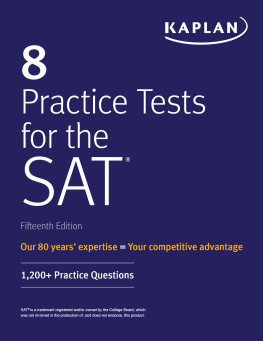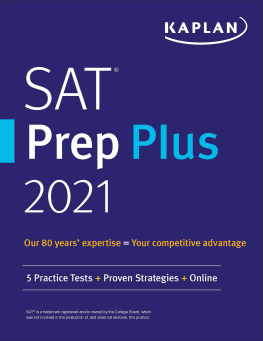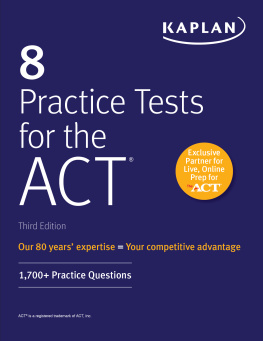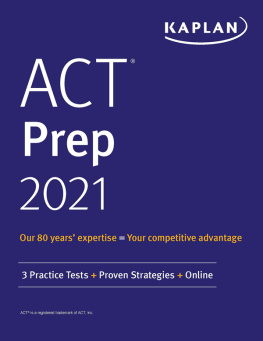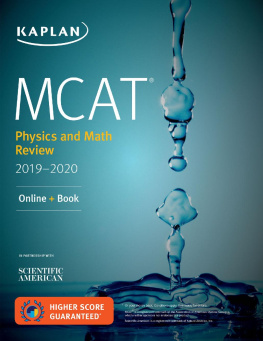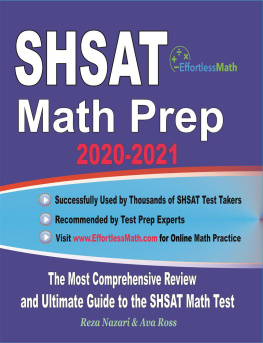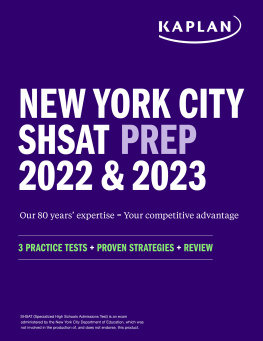
Lead Editor
Katy Haynicz-Smith, MA
Contributing Editor
Laura Aitcheson, MLIS
Special thanks to our writers and reviewers on this edition: Becky Berthiaume, Patrick Cox, Amy Craddock, Michael Collins, Thomas Darragh, Jonathan Habermacher, Mark Feery, Jennifer Land, Jo LAbbate, Karen McCulloch, Laila Sahir, Anne Marie Salloum, Kathryn Sollenberger, Bonnie Wang, and Ethan Weber
Additional special thanks to the following for their contributions to this text: Naomi Beesen, Kelly Black, Connell Boyle, Matthew Callan, Megan Dusenbery, Joanna Graham, Adam Grey, Peter Haynicz-Smith, Jesika Islam, Rebecca Knauer, Mandy Luk, Jenn Moore, Camellia Mukherjee, Kristin Murner, Monica Ostolaza, Chris Ryan, Alexandra Strelka, Rebecca Truong, Oscar Velazquez, Shayna Webb-Dray, and Amy Zarkos
SHSAT (Specialized High Schools Admissions Test) is a test administered by the New York City Department of Education, which was not involved in the production of, and does not endorse, this product.
This publication is designed to provide accurate information in regard to the subject matter covered as of its publication date, with the understanding that knowledge and best practice constantly evolve. The publisher is not engaged in rendering medical, legal, accounting, or other professional service. If medical or legal advice or other expert assistance is required, the services of a competent professional should be sought. This publication is not intended for use in clinical practice or the delivery of medical care. To the fullest extent of the law, neither the Publisher nor the Editors assume any liability for any injury and/or damage to persons or property arising out of or related to any use of the material contained in this book.
2020 by Kaplan, Inc.
Published by Kaplan Publishing, a division of Kaplan, Inc.
750 3rd Avenue
New York, NY 10017
All rights reserved under International and Pan-American Copyright Conventions. By payment of the required fees, you have been granted the non-exclusive, non-transferable right to access and read the text of this eBook on screen. No part of this text may be reproduced, transmitted, downloaded, decompiled, reverse engineered, or stored in or introduced into any information storage and retrieval system, in any form or by any means, whether electronic or mechanical, now known or hereinafter invented, without the express written permission of the publisher.
ISBN-13: 978-1-5062-5095-3
PART ONE
Getting Started
Chapter 1
SHSAT Basics
Chapter Objectives
By the end of this chapter, you will be able to:
- Answer common questions about the Specialized High Schools Admissions Test
- Take advantage of the tests structure
- Approach the questions strategically
Common Questions About the SHSAT
Youre using this book because youre serious about attending high school at Brooklyn Latin, Stuyvesant, Bronx Science, Brooklyn Tech, City College, Lehman College, Staten Island Tech, or York College. You probably already know that if you want to go to one of these specialized high schools, you have to take the Specialized High Schools Admissions Test (SHSAT). Fortunately, there are some steps you can take to maximize your score. Essentially, you need to:
- Understand the structure of the test
- Hone your Math and English Language Arts skills
- Develop strategies and test-taking techniques
- Practice what youve learned
The Specialized High Schools Admissions Test (SHSAT) is a standardized test. Its certainly not easy, but it is a fairly predictable test. This means that you can prepare for the content and question types that youll see on Test Day.
Before delving into the specific content and strategies you will need to perform well on the SHSAT, you should know some basic information about the test. Here are answers to some common questions about the SHSAT.
Why Should I Take the SHSAT?
If you want to attend high school at Brooklyn Latin, Stuyvesant, Bronx Science, Brooklyn Tech, City College, Lehman College, Staten Island Tech, or York College, you must take the SHSAT. It is the sole criterion for admission. This means that your grades, extracurricular activities, and so on play no role in the admissions process. Do not take the test if you are not serious about attending one of the schools! If you score high enough to be accepted at a school, you will be expected to attend.
Who Administers the Test?
The New York City Department of Education administers the test. The Department of Education is composed of teachers and administrators who decide what students at New York City high schools need to learn.
SHSAT Expert Note
What Does the SHSAT Stand for?
The full name of the test is the Specialized High Schools Admissions Test. SHSAT is just a bit easier to say.
How Is the Test Scored?
Composite Score
The Composite Score is based on 800 points. The number of correct answers from the Math and English Language Arts (ELA) sections determines the Composite Score. In calculating the Composite Score, the Math and ELA sections are weighted equally.
Raw Score
The Raw Score is the sum of the correct answers from each section. There are 57 questions per section; however, 10 questions per section are experimental. The experimental questions are not scored. Therefore, the maximum number of scored answers per section is 47. Overall, the highest Raw Score for the total test is 94. The Raw Score is converted to the 800-point scale to determine the Composite Score.
Experimental Questions
The 10 experimental questions per section are mixed in with the scored questions. You will not know if a question is experimental or scored. Therefore, you should answer all questions as if they will be scored.
What Is a Good Score?
Thats a good question, but there is no magic number that will guarantee admission. Admission to each specialized high school works like this: the Department of Education identifies the number of places available at each school. If there are 500 spaces available at Stuyvesant, the Board of Education accepts the top 500 scorers who identified Stuyvesant as their first choice. Therefore, you should just work to get the best score you can.
What Should I Bring to the Test?
You need your admissions ticket, two or more No. 2 pencils, an eraser, and a watch that does not contain a calculator. You may not bring a calculator to the test.
Taking Advantage of the SHSATs Structure
You can be confident that the test will look very similar to the test-like practice in this book. Therefore, you can take advantage of the tests predictability and use what you know about the structure to raise your score.
You Do Not Need to Answer the Questions in Order
Usually, when taking a test, you automatically answer the questions in the order that theyre written. However, there are a lot of questions on the SHSAT, and you may be able to make it easier on yourself by doing the questions you find easier first. For example, if youre good at Reading Comprehension questions, build your confidence and grab some quick points by doing them first. Or if you have a tough time with coordinate geometry, skip the coordinate geometry questions and go back to them when you have time.
You Can Move Between Sections
Most standardized tests dont let you move between sections or go back and check your work on a section youve already completed. On the SHSAT, however, you can go back to the English Language Arts section after youve finished the Math section.
Next page


